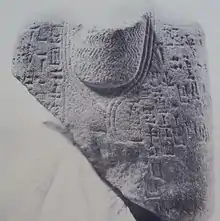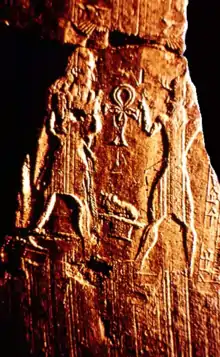List of kings of Ebla
The list of kings of Ebla includes the known monarchs of Ebla who ruled three consecutive kingdoms. For the first kingdom's monarchs, tablets listing offerings to kings mention ten names,[1] and another list mentions 33 kings.[note 1][3][2] No kings are known from the second kingdom and all dates are estimates according to the Middle chronology.[4][5]
The list

Ibbit-Lim statue, dated to the third kingdom c. 2000 BC

Seated ruler, dated to the third kingdom, exhibited at the Cleveland Museum of Art

Prince Maratewari (left), crown prince of king Indilimma
| Ruler | Reigned | Comments | ||
|---|---|---|---|---|
|
The first kingdom | ||||
| Sakume | c. 3100 BC.[6] | The first king ruled approximately 660 years before the destruction of the first kingdom; the year 2400 was used by Robert R Stieglitz as the date of the destruction resulting in the year c. 3100 BC for the beginning of Sakume's reign.[7] | ||
| Su (.) (...) | Name damaged.[3] | |||
| Ladau | ||||
| Abugar | ||||
| Namnelanu | ||||
| Dumudar | ||||
| Ibla | ||||
| Kulbanu | ||||
| Assanu | ||||
| Samiu | ||||
| Zialu | ||||
| Enmanu | c. 2740 BC[4] | |||
| Namanu | c. 2720 BC.[4] | |||
| Da (.) (.) | c. 2700 BC.[4] | Name damaged.[3] | ||
| Sagisu | c. 2680 BC.[4] | |||
| Dane'um | c. 2660 BC.[4] | |||
| Ibbini-Lim | c. 2640 BC.[4] | |||
| Ishrut-Damu | c. 2620 BC.[4] | |||
| Isidu | c. 2600 BC.[4] | |||
| Isrut-Halam | c. 2580 BC.[4] | |||
| Iksud | c. 2560 BC.[4] | |||
| Talda-Lim | c. 2540 BC.[4] | |||
| Abur-Lim | c. 2520 BC.[4] | |||
| Agur-Lim | c. 2500 BC.[4] | |||
| Ib-Damu | c. 2480 BC.[4] | A seal bearing his name was found in Kültepe.[8] | ||
| Baga-Damu | c. 2460 BC.[4] | |||
| Enar-Damu | c. 2440 BC.[4] | Amongst the most referenced deified kings in the offering lists.[6] | ||
| Eshar-Malik | c. 2420 BC.[4] | |||
| Kun-Damu | c. 2400 BC.[4] | |||
| Adub-Damu | c. 2380 BC.[4] | Short reign.[9] | ||
| Igrish-Halam | c. 2360 BC.[4] | Ruled 12 years.[10] | ||
| Irkab-Damu | c. 2340 BC.[4] | Ruled 11 years.[11] | ||
| Isar-Damu | c. 2320 BC.[4] | Ruled about 35 years.[11] | ||
| Ir'ak-Damu | A prince, might have ascended the throne for a short period.[3] | |||
|
The third kingdom | ||||
| Ibbit-Lim | c. 2000 BC.[12] | |||
| Immeya | c. 1750 BC.[13] | His grave is identified with the so-called "Tomb of the Lord of the Goats".[14] | ||
| Hammu(....) | A successor of Immeya, not necessarily the direct one, the name was damaged but probably Hammurabi.[15] | |||
| Indilimma | c. 1600 BC.[16] | |||
Notes
- Tablet TM.74.G.120 discovered by Alfonso Archi.[2]
References
Citations
- Bryce 2014, p. 16.
- Stieglitz 2002, p. 218.
- Stieglitz 2002, p. 219.
- Hamblin 2006, p. 241.
- Frayne 2008, p. 44.
- Stieglitz 2002, p. 222.
- Stieglitz 2002, p. 221.
- Archi 2002, p. 25.
- Dolce 2008, p. 68.
- Frayne 2008, p. 3-16.
- Archi 2011, p. 5.
- Pettinato 1981, p. 27.
- Aruz, Graff & Rakic 2013, p. 10.
- Matthiae 2008, p. 35.
- Matthiae 2010, p. 218.
- Matthiae 2006, p. 86.
Sources
- Bryce, Trevor (2014). Ancient Syria: A Three Thousand Year History. Oxford University Press. ISBN 978-0-19-100292-2.CS1 maint: ref=harv (link)
- Hamblin, William J. (2006). Warfare in the Ancient Near East to 1600 BC. Routledge. ISBN 978-1-134-52062-6.CS1 maint: ref=harv (link)
- Pettinato, Giovanni (1981). The archives of Ebla: an empire inscribed in clay. Doubleday. ISBN 978-0-385-13152-0.CS1 maint: ref=harv (link)
- Aruz, Joan; Graff, Sarah B.; Rakic, Yelena, eds. (2013). Cultures in Contact: From Mesopotamia to the Mediterranean in the Second Millennium B.C. Metropolitan Museum of Art. ISBN 978-1-58839-475-0.CS1 maint: ref=harv (link)
- Matthiae, Paolo (2006). "The Archaic Palace at Ebla: A Royal Building between Early Bronze Age IVB and Middle Bronze Age I". In Gitin, Seymour; Wright, J. Edward; Dessel, J. P. (eds.). Confronting the Past: Archaeological and Historical Essays on Ancient Israel in Honor of William G. Dever. Eisenbrauns. ISBN 978-1-57506-117-7.CS1 maint: ref=harv (link)
- Matthiae, Paolo (2010). Ebla: la città del trono : archeologia e storia. Piccola biblioteca Einaudi: Arte, architettura, teatro, cinema, música (in Italian). 492. Einaudi. ISBN 978-88-06-20258-3.CS1 maint: ref=harv (link)
- Matthiae, Paolo (2008). "Ebla". In Aruz, Joan; Benzel, Kim; Evans, Jean M. (eds.). Beyond Babylon: Art, Trade, and Diplomacy in the Second Millennium B.C.. Metropolitan Museum of Art. ISBN 978-1-58839-295-4.CS1 maint: ref=harv (link)
- Archi, Alfonso (2011). "In Search of Armi". Journal of Cuneiform Studies. The American Schools of Oriental Research. 63: 5–34. doi:10.5615/jcunestud.63.0005. ISSN 2325-6737.CS1 maint: ref=harv (link)
- Frayne, Douglas (2008). Pre-Sargonic Period: Early Periods (2700–2350 BC). The Royal inscriptions of Mesopotamia Early Periods. 1. University of Toronto Press. ISBN 978-1-4426-9047-9.CS1 maint: ref=harv (link)
- Stieglitz, Robert R. (2002). "The Deified Kings of Ebla". In Gordon, Cyrus Herzl; Rendsburg, Gary (eds.). Eblaitica: Essays on the Ebla Archives and Eblaite Language. 4. Eisenbrauns. ISBN 978-1-57506-060-6.CS1 maint: ref=harv (link)
- Archi, Alfonso (2002). "Formation of the West Hurrian Pantheon: The Case Of Ishara". In Yener, K. Aslihan; Hoffner, Harry A.; Dhesi, Simrit (eds.). Recent Developments in Hittite Archaeology and History. Eisenbrauns. ISBN 978-1-57506-053-8.CS1 maint: ref=harv (link)
- Dolce, Rita (2008). "Ebla before the Achievement of Palace G Culture: An Evaluation of the Early Syrian Archaic Period". In Kühne, Hartmut; Czichon, Rainer Maria; Kreppner, Florian Janoscha (eds.). Proceedings of the 4th International Congress of the Archaeology of the Ancient Near East, 29 March - 3 April 2004, Freie Universität Berlin. 2. Otto Harrassowitz Verlag. ISBN 978-3-447-05757-8.CS1 maint: ref=harv (link)
This article is issued from Wikipedia. The text is licensed under Creative Commons - Attribution - Sharealike. Additional terms may apply for the media files.